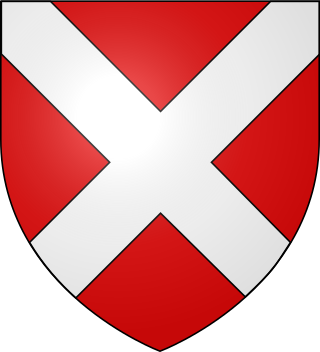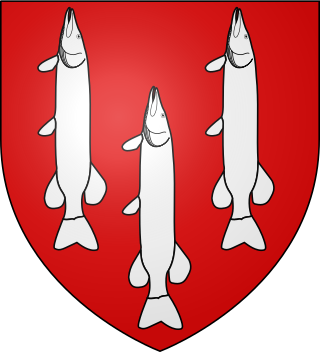
Earl of Derby is a title in the Peerage of England. The title was first adopted by Robert de Ferrers, 1st Earl of Derby, under a creation of 1139. It continued with the Ferrers family until the 6th Earl forfeited his property toward the end of the reign of Henry III and died in 1279. Most of the Ferrers property and the Derby title were then held by the family of Henry III. The title merged in the Crown upon Henry IV's accession to the throne in 1399.

Sir Reginald Bray was an English administrator and statesman. He was the Chancellor of the Duchy and County Palatine of Lancaster under Henry VII, briefly Treasurer of the Exchequer, and one of the most influential men in Henry VII's government and administration. He was an estate officer and senior councillor to both Henry VII and the king's mother, Margaret Beaufort. He was a major benefactor to St George's Chapel, Windsor, where some of the building work for which he provided funds can still be seen and identified.

Reynold Grey, 3rd Baron Grey of Ruthyn, a powerful Welsh marcher lord, succeeded to the title on his father's death in July 1388.
William II de Ferrers, 4th Earl of Derby, was a favourite of King John of England. He succeeded to the estate upon the death of his father, William de Ferrers, 3rd Earl of Derby, at the Siege of Acre in 1190. He was head of a family which controlled a large part of Derbyshire which included an area known as Duffield Frith.

Ralph Neville, 2nd Baron Neville of Raby was an English aristocrat, the son of Ralph Neville, 1st Baron Neville de Raby by Eupheme de Clavering.

William Brewer of Tor Brewer in Devon, was a prominent administrator and judge in England during the reigns of kings Richard I, his brother King John, and John's son Henry III. He was a major landholder and the founder of several religious institutions. In 1204, he acquired the feudal barony of Horsley in Derbyshire.

de Lucy or de Luci is the surname of an old Norman noble family originating from Lucé in Normandy, one of the great baronial Anglo-Norman families which became rooted in England after the Norman conquest. The first records are about Adrian de Luci who went into England after William the Conqueror. The rise of this family might have been due to Henry I of England, although there are no historical proofs that all de Lucys belonged to the same family. The family name is Gallo-Roman, mentioned in 616 as Luciacus, Lucy, Luci, Lucé derived from the Latin cognomen Lucius, meaning "born with the daylight" or Gaulish Lucus, Lucius, Lucco from Loco- / Luco- possibly "wolf" + suffix -(i)acum "place, property" of Gaulish origin.

Scot's Hall was a country house in Smeeth, between Ashford and Folkestone in southeast England. It was the property of a gentry family, the Scotts. The first known resident was Sir John Scott, who married Caroline Carter.
Reginald de Warenne was an Anglo-Norman nobleman and royal official. The third son of an earl, Reginald began his career as an administrator of his brother's estates, and continued to manage them for his brother's successor, William, the second son of King Stephen. Reginald was involved in the process that led to the peaceful ascension of Henry fitzEmpress to the throne of England in 1154 and served the new king as a royal justice afterwards. He played a minor role in the Becket controversy in 1170, as a member of the party that met Becket on his return to England from exile in 1170.
Hugh de Cressy was an Anglo-Norman administrator and nobleman. Little is known of his ancestry and he first served two brothers of King Henry II of England before becoming a royal official. He was rewarded with a marriage to an heiress for his service to the king. In England he often served as a royal justice and witnessed documents, which showed his closeness to the king. On the continent, he recruited mercenaries for the royal army and was named constable of the castle of Rouen in the royal lands in France. He died in 1189 after giving lands to various monasteries before his death.
Sir Thomas Chaworth was an English landowner and Member of Parliament. He and his second wife, Isabel Chaworth, became one of the richest family's in England when his wife unexpectantly inherited the estate of Hugh Aylesbury of Milton Keynes.

Peter FitzHerbert, also known as Piers FitzHerbert, Lord of Blenlevenny, was a 13th-century nobleman and Sheriff of Yorkshire. FitzHerbert was one of the Counsellors named in Magna Carta in 1215. He was the son of Herbert FitzHerbert and Lucy of Hereford.

Reginald FitzPiers, also known as Reynold FitzPiers, Lord of Blenlevenny was a 13th-century English nobleman and Sheriff of Hampshire. He was the second son of Peter FitzHerbert and Alice de Warkworth, and following the death of his brother inherited the minor Marcher Lordship of Blaenllynfi from him.

The title Baron Cobham has been created numerous times in the Peerage of England; often multiple creations have been extant simultaneously, especially in the fourteenth century.

John FitzReginald, also known as John FitzReynold, Lord of Blenlevenny was an English noble. He was a signatory of the Barons' Letter of 1301.
Reginald FitzReginald, also known as Reynold FitzReynold, Lord of Hinton Martell, was an English noble.
Peter FitzReginald, also known as Piers FitzReynold, Lord of Chewton was an English noble.

Sir Adam de Everingham, 2nd Baron Everingham, Lord of Laxton, was an English noble who fought during the Second War of Scottish Independence and the Hundred Years' War.

Richard de Luci, sometimes spelt Lucy, Baron of Egremont and Copeland, was an English noble.
Alan de Multon, Lord of Papcastle, who held lands in Cockermouth, was an English noble.